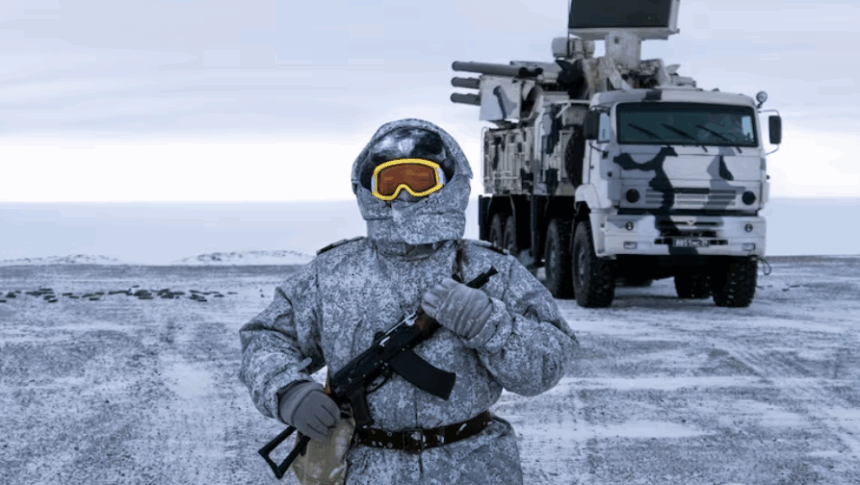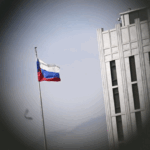Summary by Geopolist | Istanbul Center for Geopolitics:
In April 2022, just two months after launching the full-scale invasion of Ukraine, Vladimir Putin did something unexpected. Instead of huddling with his generals or giving televised speeches about the war, he convened a high-level meeting on Russia’s Arctic policy. It wasn’t just symbolic. That moment crystallized something many analysts had quietly been observing: the Arctic wasn’t a sideshow in Russia’s global strategy—it was becoming the stage.
By late 2022, Putin was openly calling the Arctic and the Far East “the regions where Russia’s future lies.” His government began using the word osvoenie—a term loaded with historical meaning, roughly translating to “development” or “mastery”—to describe what they envisioned. For those familiar with Soviet rhetoric, the message was clear: Russia would not just develop the Arctic. It would conquer it—economically, demographically, and militarily.
Beneath the Ice: Russia’s “Policy Iceberg”
The transformation of Russia’s Arctic strategy is best understood as a layered construct—what one analyst aptly dubbed a “policy iceberg.”
At the visible tip of the iceberg lies the story the Kremlin wants the world to see: one of heroic national development. There’s the construction of roads and railways, the promise of jobs in remote towns, and sleek promotional videos of nuclear-powered icebreakers slicing through frozen seas. This is the realm of Deputy Prime Minister Yury Trutnev, who has led Russia’s development initiatives in the region. His vision is unapologetically ambitious: populate the north, extract its riches, and build a modern industrial base on the edge of the Earth.
Just below the waterline, however, is a more complicated reality. Take the Northern Sea Route (NSR), for example. Billed as Russia’s future Suez Canal, it’s a shipping corridor that could, in theory, link Europe and Asia by slicing through the Arctic Ocean. But while Trutnev and others sell it as an open trade route, the NSR is becoming increasingly closed—its operations controlled by state nuclear agency Rosatom, its regulations designed to limit foreign access. The more one examines the NSR, the clearer it becomes: its economic promise is being slowly overwhelmed by military paranoia.
And then there’s the submerged base of the iceberg—the part that’s not meant to be seen at all. This is the domain of Nikolai Patrushev, a former intelligence chief and longtime Putin confidant. Here, Russia’s Arctic strategy reveals its darker ambitions: expanded naval deployments, revival of Soviet-era bases, nuclear submarine bastions, and covert operations that blur the line between espionage and sabotage.
The Roots of Insecurity: What Drives the Kremlin Northward
Russia’s Arctic policy isn’t just about ambition. It’s also about fear—fear of being encircled, of falling behind, of losing control.
Militarily, the Arctic is central to Russia’s nuclear deterrent. A large portion of its second-strike capability—the ability to respond to a nuclear attack—is based on submarines patrolling the icy northern seas. But with global warming shrinking the ice cover and NATO expanding its presence in the region (especially after Finland and Sweden joined the alliance), these submarines are increasingly exposed. What was once a natural fortress is now a melting vulnerability.
Economically, the stakes are equally high. Russia depends heavily on oil and gas revenues, and a growing share of its reserves are in the Arctic. But extracting them is difficult. Offshore fields are remote and technologically demanding. When the West imposed sanctions after Russia’s annexation of Crimea in 2014, critical joint ventures—like the one with ExxonMobil—were cut off. With access to foreign technology blocked, development stalled. What the Kremlin saw was not just a financial setback, but a strategic assault on its sovereignty.
People at the Edge: A Struggle to Populate the North
Despite the heavy industrial rhetoric, Arctic development in Russia is, at its core, a human challenge. Millions once lived and worked across the Arctic under Soviet industrial schemes. Today, that number has shrunk by nearly a third. Many Arctic towns are shells of what they once were—plagued by isolation, crumbling infrastructure, and a harshness that pushes young people to flee south.
The Kremlin has tried to reverse this trend. It’s offered subsidized mortgages, free land grants, and new urban masterplans to attract families back to the north. But for many would-be settlers, the incentives don’t outweigh the hardships. A 2025 government study admitted what locals already knew: despite the cash and construction, nearly one-third of residents still planned to leave.
The NSR: Between Trade Route and Military Corridor
One of the most contested elements of Russia’s Arctic plan is the Northern Sea Route. On the surface, it’s about logistics and commerce: melting ice opens a shorter path between Europe and Asia. But in practice, it’s a tug-of-war between two visions.
Trutnev’s team wants to globalize the corridor, welcome foreign investment, and boost cargo traffic. Patrushev’s camp sees every foreign ship as a security threat, every container as a possible Trojan horse. The result is a compromised strategy. Regulations have grown stricter. Icebreaker escorts are mandatory. Foreign transit has dropped to nearly zero.
What could have been a showcase of Arctic openness is becoming a closed military artery—policed by Russia’s navy, equipped with dual-use icebreakers, and closely monitored by the FSB.
Invisible Threats: Sabotage, Satellites, and Indigenous Diplomacy
Russia’s Arctic militarisation doesn’t stop at bases and submarines. Increasingly, it includes covert actions meant to pressure and unsettle Western adversaries.
Since 2022, there’s been a sharp rise in hybrid operations: undersea cable sabotage, drone flyovers near NATO facilities, GPS jamming in northern Scandinavia. These tactics are hard to attribute directly, which makes them even more effective as tools of deniable disruption. They’re a way to keep adversaries off balance—never quite sure what’s coming next.
But the Kremlin’s reach extends further still. It has also weaponized environmental and Indigenous issues. Before 2020, Moscow engaged in climate and Indigenous diplomacy largely to please the West. That changed after the Ukraine invasion. Today, environmental cooperation has been suspended, Indigenous advocacy groups have been co-opted or silenced, and Arctic climate data has vanished from global networks—turning once-collaborative forums into another front in the geopolitical contest.
Diplomacy on Ice: Moscow’s Balancing Act Between China, India, and the West
Even as it turns inward and militarizes, Russia hasn’t given up on Arctic diplomacy. But its approach is opportunistic, not cooperative.
Moscow continues to use international law selectively. It invokes the UN Convention on the Law of the Sea (UNCLOS) when it supports its continental shelf claims, but threatens to abandon it when legal challenges emerge. It joined Arctic Council agreements on search-and-rescue and oil-spill responses but suspended cooperation when the Council criticized its invasion of Ukraine.
At the same time, the Kremlin courts alternative partners—particularly China and India. With China, the relationship is pragmatic but tense. Beijing wants more say, especially over the NSR, but Russia keeps a tight grip. India, seen as less threatening, is welcomed as a junior partner in scientific and logistical cooperation. These alliances serve a dual purpose: they show Russia isn’t isolated and give it bargaining chips in potential negotiations with the U.S. or Europe.
Europe on Thin Ice: Caught Between the Kremlin and the White House
For Europe, the Arctic is no longer just about science, sustainability, and climate policy. It’s becoming a strategic frontier where European interests could be sidelined.
If the United States—particularly under a more transactional leadership—strikes a deal with Russia over Arctic cooperation or shelf claims, European and Canadian interests might be left out. Such a deal could include symbolic gestures like limiting Chinese involvement in the NSR in exchange for easing sanctions or making territorial concessions elsewhere—most likely in Ukraine.
Europe cannot afford to be passive. To protect its influence in the Arctic, it must strengthen ties with Canada, Greenland, Iceland, and Indo-Pacific actors like Japan and South Korea. It should also modernize its Arctic policy to reflect the new military and strategic realities—not just environmental goals.
The Arctic as Bargaining Chip—and Battlefield
In the Kremlin’s long-term strategy, the Arctic is more than a region. It is a stage—a symbol of national pride, a storehouse of resources, and a future platform for global leverage. As Russia’s domestic institutions erode and its economy buckles under war and sanctions, the Arctic remains one of the few places where the state can project power and purpose.
But this projection comes at a cost. Underneath the ice is a hardening militarism, a growing willingness to blur civilian and military boundaries, and a worldview increasingly shaped by siege mentality and revanchist ambition.
The question for the rest of the world—especially for Europe—is whether to confront this reality head-on, or to let the iceberg drift until its full mass becomes impossible to ignore.
Read more here.







